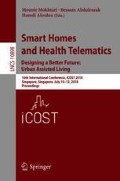Abstract
Internet Of Things (IoT) is increasingly used throughout the world in different fields. But it does not have a standardized definition [28]. Several definition can be proposed. IoT corresponds to “objects with virtual identity and personality, working in a smart environment and using smart interfaces to connect and communicate in some various context” [3]. IoT is a sum of entities that are used to exchange information in different contexts. This is a network of connected objects communicating between them to extend their functionalities [17]. The IoT is larger than just a system: it is a system of system. Each one can be divided in sub-system and assimilated to a specific technology [5]. The IoT is “a dynamic infrastructure of a global network. This global network has auto-configuration capacities based on standards and communication protocols interoperable. In this network, physical and virtual objects have identities, physical attributes, virtual personalities and smart interfaces and they are integrated to the network in a transparent way” [31].
Access this chapter
Tax calculation will be finalised at checkout
Purchases are for personal use only
References
Azéma, B., Martinez, N.: Les personnes handicapées vieillissantes: espérances de vie et de santé; qualité de vie. Rev. française des affaires sociales. 2(2), 295–333 (2005)
Baltes, P.B., Freund, A.M., Li, S.-C.: The Psychological Science of Human Ageing. Cambridge University Press, Cambridge (2005)
Bassi, A., Horn, G.: Internet of things in 2020: a roadmap for the future. Eur. Common. Inf. Soc. Media 22, 97–114 (2008)
Belio, C.: Handicap, cognition et représentations. Ph.D. thesis, Bordeaux 2 (2012)
Benghozi, P-.J., Bureau, S., Massit-Folea, F.: L’internet des objets. quels enjeux pour les européens? (2008)
Bijker, W.E.: Of Bicycles, Bakelites, and Bulbs: Toward a Theory of Sociotechnical Change. MIT Press, Cambridge (1997)
Briançon, S., Guèrin, G., Sandrin-Berthon, B.: Les maladies chroniques. Actualités Dossiers En Santé Publique, pp. 11–53 (2010)
Brunet, R., Ferra, R., Théry, H.: Les mots de la géographie, dictionnaire critique. GIR RECLUS/La Documentation française (1992)
Bussière, C.: Recours aux soins de santé primaires des personnes en situation de handicap: analyses économiques à partir des données de l’enquête Handicap-Santé. Ph.D. thesis, Université Paris-Saclay (2016)
Chaudet, B.: Handicap, vieillissement et accessibilité. Exemples en France et au Québec. Ph.D. thesis, Université Paris-Saclay (2016)
Covelet, R.: Prendre enfin conscience des enjeux des déficits sensoriels des personnes âgées. Gérontol. soc. 30(4), 249–262 (2007)
Despouy, L.: Human Rights and Disabled Persons. United Nations (1993)
Folcher, V., Lompré, N.: Accessibilité pour et dans l’usage: concevoir des situations d’activité adaptées à tous et à chacun. Le trav. hum. 75(1), 89–120 (2012)
Fried, L.P., Tangen, C.M., Walston, J., Newman, A.B., Hirsch, C., Gottdiener, J., Seeman, T., Tracy, R., Kop, W.J., Burke, G., et al.: Frailty in older adults: evidence for a phenotype. J. Gerontol. Ser. A Biol. Sci. Med. Sci. 56(3), M146–M157 (2001)
Gohet, P.: L’avancée en âge des personnes handicapées contribution à la réflexion. Rapport, Paris (2013)
Grossman, M., et al.: The Demand for Health: A Theoretical and Empirical Investigation. NBER Books, New York (1972)
Gubbi, J., Buyya, R., Marusic, S., Palaniswami, M.: Internet of things (IoT): a vision, architectural elements, and future directions. Future Gener. Comput. Syst. 29(7), 1645–1660 (2013)
ISO: Ergonomics of human-system interaction: Part 210: Human-centred design for interactive systems (2010)
Kirkwood, T.B.L.: A systematic look at an old problem. Nature 451(7179), 644 (2008)
Ladislas, R.: Le vieillissement. faits et théories (1995)
Marinc, A., Stocklöw, C., Braun, A., Limberger, C., Hofmann, C., Kuijper, A.: Interactive personalization of ambient assisted living environments. In: Smith, M.J., Salvendy, G. (eds.) Human Interface 2011. LNCS, vol. 6771, pp. 567–576. Springer, Heidelberg (2011). https://doi.org/10.1007/978-3-642-21793-7_64
Martel, L., Bélanger, A.: Une analyse de l’évolution de l’espérance de vie sans dépendance au canada entre 1986 et 1996. Rapport sur l’état de la population du Canada 1998–1999, pp. 164–186 (1998)
Mokhtari, M., Aloulou, H., Tiberghien, T., Biswas, J., Racoceanu, D., Yap, P.: New trends to support independence in persons with mild dementia-a mini-review. Gerontology 58(6), 554–563 (2012)
OMS: Rapport mondial sur le vieillissement et la santé (2016)
Roche, A.: Proposition d’une méthode de conception systémique d’interface homme-système adaptée aux situations de multihandicap. Ph.D. thesis, Université de Bordeaux (2015)
Seydoux, N., Drira, K., Hernandez, N., Monteil, T.: Rôle d’une base de connaissance dans semiotics, un système autonome contrôlant un appartement connecté (2016)
Shin, D.-H.: A socio-technical framework for cyber-infrastructure design: implication for Korean cyber-infrastructure vision. Technol. Forecast. Soc. Change 77(5), 783–795 (2010)
Shin, D.: A socio-technical framework for internet-of-things design: a human-centered design for the internet of things. Telemat. Inform. 31(4), 519–531 (2014)
Sommerville, I., Dewsbury, G.: Dependable domestic systems design: a socio-technical approach. Interact. Comput. 19(4), 438–456 (2007)
Steves, C.J., Spector, T.D., Jackson, S.H.D.: Ageing, genes, environment and epigenetics: what twin studies tell us now, and in the future. Age Ageing 41(5), 581–586 (2012)
Sundmaeker, H., Guillemin, P., Friess, P., Woelfflé, S.: Vision and challenges for realising the internet of things. Clust. Eur. Res. Proj. Internet Things, Eur. Comm. 3(3), 34–36 (2010)
UNO: World population ageing 2013. Department of Economic and Social Affairs PD (2013)
Robert, L., West, R.L.: An application of prefrontal cortex function theory to cognitive aging. Psychol. Bull. 120(2), 272 (1996)
Winter, J.: The internet of things: scenarios for a human-centered design and policy process. In: Conference Paper Presented at the World Futures Studies Federation 40th Anniversary Conference, Bucharest. Romania, June 2013
Author information
Authors and Affiliations
Corresponding authors
Editor information
Editors and Affiliations
Rights and permissions
Copyright information
© 2018 Springer International Publishing AG, part of Springer Nature
About this paper
Cite this paper
Chibaudel, Q., Joaquim, B., Véronique, LN., Mounir, M. (2018). Human Centered Design Conception Applied to the Internet of Things: Contribution and Interest. In: Mokhtari, M., Abdulrazak, B., Aloulou, H. (eds) Smart Homes and Health Telematics, Designing a Better Future: Urban Assisted Living. ICOST 2018. Lecture Notes in Computer Science(), vol 10898. Springer, Cham. https://doi.org/10.1007/978-3-319-94523-1_2
Download citation
DOI: https://doi.org/10.1007/978-3-319-94523-1_2
Published:
Publisher Name: Springer, Cham
Print ISBN: 978-3-319-94522-4
Online ISBN: 978-3-319-94523-1
eBook Packages: Computer ScienceComputer Science (R0)

